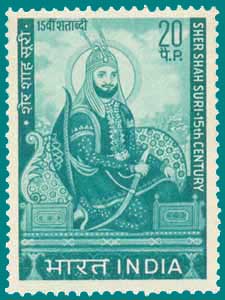Sher Shah Suri, "The Lion King", founder of the Suri Dynasty, was born in 1472 in Punjab. His original name was Farid. He was the son of a petty Afghan Jagirdar. Ill-treated by his stepmother, he left home at an early age. He went to Jaunpur where he set himself to serious study and there he acquired good command over the Arabic and Persian languages. Because of his abilities, he was soon appointed by his father to manage the family Jagir. But again because of his stepmother, he left his father's Jagir and went to Bihar where he later joined the service of Babur.
Seeing the weaknesses in the Mughal rule and military organization, Sher Shah took advantage of the problems faced by Humayun. Eventually he managed to overthrow the Mughal rulers. His reign barely spanned five years, but is a landmark in the history of the Sub-continent. With his deep knowledge and practical experience, he made many brilliant additions and improvements to the existent system. Sher Shah was a capable military and civilian administrator. He set up reforms in various areas. Akbar later built on these reforms and extended them further. Many of these reforms pertained to the army, but the principal reforms for which he is remembered are those connected with revenue administration. Numerous civil works were carried out during his short reign.
Sher Shah ruled for a short period of five years in which he not only consolidated his power but also brought about important reforms. He died in 1545 from a gunpowder explosion. He was a practical and farsighted ruler who was way ahead of his contemporaries. He is remembered in history for the numerous reforms that he undertook to strengthen the government. He was in truth the greatest ruler that sat upon the throne of Delhi.
SHER SHAH SURI AND EARY MUGHALS |
In 1538, Farid Khan, better known as Farid-ud-din Abul Muzaffar Shîr Shâh Sûr, an Afghan who had already become ruler of Bihar, captured Bengal, and appointed muhammad khan sur as the governor of Bengal. Nasir al-Din Muhammad Humayun, son of Babar, took back gaur, renamed it Jannatabad, and when he left gauD.a, he made Quli Beg the governor. Humayun ultimately lost in 1539 and again in 1540; so that Sher Shah became emperor of India (1540–died May 22, 1545). However, caTTagrAma never came under his power, and the Arakan king soon took it over, and held it till 1666. In 1541, his governor Khijr Khan of Bengal started acting independent, so he was removed and Qazi Fazilat = Fazzihat made the governor. Sher Shah built the grand trunk road from sonArgà to attock following previously existing roads.
Sher Shah's son Jalal Khan ruled next as Islâm Shâh (1545–53). Under him, kAlidAsa gajadAni, a rAjput, who had converted to Islam and taken the name Sulaiman Khan, took over parts of east bengal. Two generals of Islam Shah, tAj Khan and Dariya Khan defeated him, and when he revolted again, killed him and sold his sons to Turani traders. Islam Shah's uncle Kalapahar (according to Akbar Nama, Mantkhab-ut-Twarikh, and Makhjan-i-Afghani; he is also called Raju, and there are folklores of his being born a hindu; another kalapahar is known during the time of bahlol lodi and sikander lodi) attacked Kamrup and destroyed the temples at Hajo and Kamakhya.
Islam Shah's twelve year old son Firuz Shah succeeded him, but within days was assasinated by Sher Shah's nephew muh.ammad mubâriz khân who ruled as Muhammad Shah Adil. He was a tyrannical but weak ruler, and the governors of different regions started declaring themselves independent (ibrâhîm khân in Delhi?); thus the rise of Karranis started under him. The Afghan governor of Bengal, Muhammad Khan, declared independence and started rulin as Shams-ud-din Muhammad Shah Ghazi. He started fighting against Arakan and won Jaunpur, but Muhammad Shah Adil's hindu general Hemu defeated and killed him in 1555; and Muhammad Shah Adil appointed Shahbaj Khan as ruler of Bengal. However, Shams-ud-din Muhammad Shah's son Khijr Khan declared himself sultan Ghiyas-ud-din Bahadur Shah (1555–60), and defeated Shahbaj Khan. In the meantime, Humayun recaptured power in Delhi from ah.mad khân sikandar shâh (1555), but died on the 26th of January, 1556. His son, Jalal al-din Muhammad Akbar (1556–1605, very tolerant of various religions), initially with Biram Khan as a regent, defeated Muhammad Shah Adil on the 5th of November 1556. Muhammad Shah Adil tried to move east, but Ghiyas-ud-din Bahadur Shah killed him. Ghiyas-ud-din tried to capture Jaunpur, but was defeated by the Mughals.
After Ghias-ud-din's death, his brother Jalal-ud-din ruled as Ghiasuddin Abul Muzaffar Jalal Shah (Ghiasuddin II 1560–63). The Afghan Karrani dynasty captured large tracts of south-east Bihar and west Bengal. His son (name unknown) succeeded Ghiasuddin, but was assasinated within a few months and Ghiasuddin III took over, but within a year was assasinated by Taj Khan Karrani who started the Karrani dynasty.



No comments:
Post a Comment